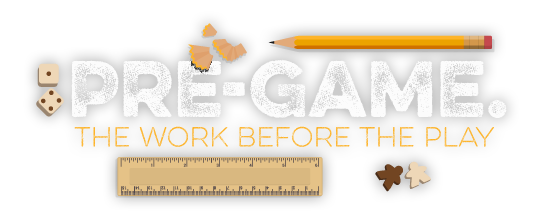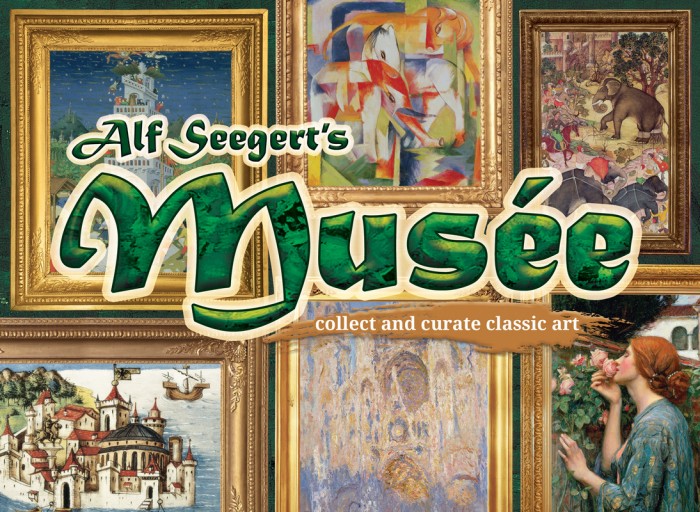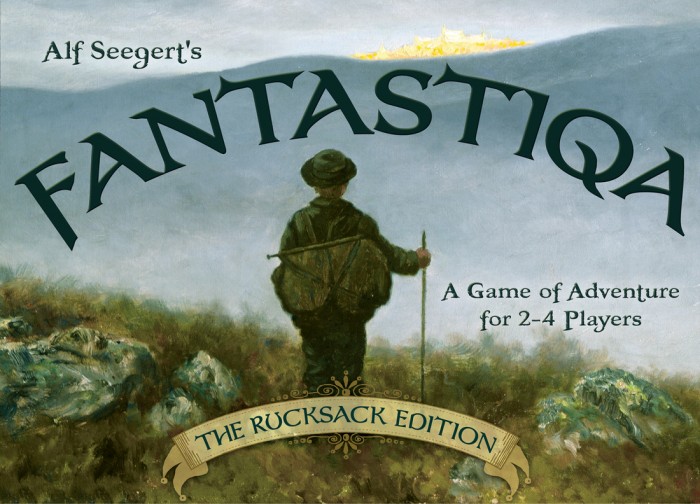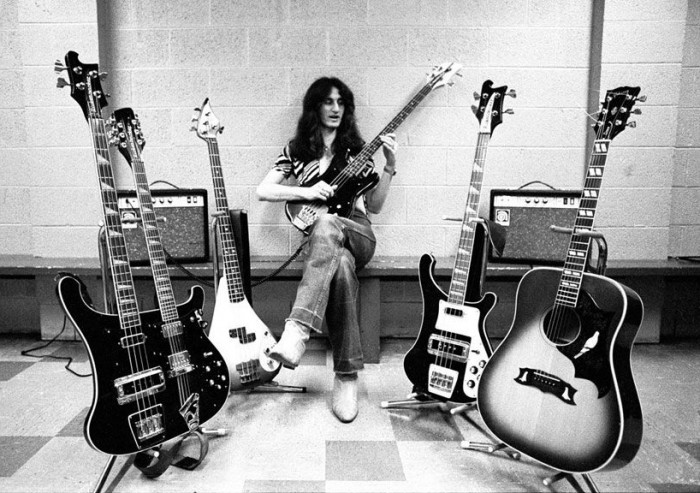
Tell us about yourself – Who are you? What do you do?
I’m Alf Seegert, designer of board games including Fantastiqa, The Road to Canterbury, Trollhalla, and Bridge Troll. My newest design is the card game Musée, and I recently co-designed a nifty dice-sculpting game, Cubist, with Steven Poelzing.
This post has affiliate links, which directly support Andhegames.com at no extra cost to you. If you have any questions about anything recommended, let me know. – Andrew
If I’ve never played your games before, what’s the first one I should try?
Hmmm….it depends. They are all quite different!
If you’re a fan of fine art, or if you want a quick and easy-to-learn game that might fire your Lost Cities-addictedneurons, try Musée.
If you’re a literature or history buff and like Chaucer — or have the exquisite taste of a Black Adder or Monty Python fan — I recommend The Road to Canterbury.
If you want a quirky (and sadly underplayed) game in which you get to pillage and plunder as Viking Sea Trolls, look no further: play Trollhalla! The art is by the illustrious Ryan Laukat.
(My interview with Ryan is over here. –A)
If you are a fan of modern art, or looking for highly accessible game which uses dice in creative new ways to sculpt works of art, try Cubist, my co-design with Steve Poelzing.
My favorite self-designed game remains the wild and weird adventure gameFantastiqa, by quite a large margin. Needless to say, I recommend it!
One fact that we probably don’t know about you:
When I was nine years old, I broke my arm defending the honor of Donna Summer as the Disco Queen.
(you’ve gotta respect that. –A)
What tabletop games (including digital board/card games) are you playing most right now?
I was late to the game with Antoine Bauza’s clever and charming Takenoko. I got it for my wife this past Christmas and we both really enjoy caring for that big Zen Garden and its hungry Giant Panda! Do you get the same glorious “Totoro vibe” that I do from the cover image?
I also recently picked up Stefan Dorra’s Medina and am quite impressed at all the nifty wooden pieces and pleasurably brain-burny gameplay.
The games we play at home the most are my own designs-in-progress.
What are your all-time favorite tabletop games?
Perhaps it’s immodest to say this, but (speaking to fellow designers here) if your own designs aren’t among your very favorite games, then you might need to work harder to design games you like… My favorite tabletop game is Fantastiqa, and yes, I’m thoroughly and egregiously biased in saying so! (I’m not saying it’s the best game, but just our favorite, and the most-often played on our table, even a few years beyond its initial release.)
My favorite all-time games by other designers include The Princes of Florence, Carcassonne: Hunters and Gatherers, and Through the Desert. And I enjoy and admire Bruno Faidutti’s Mystery of the Abbey.
More recently I’ve been highly impressed by Brian Kohrman’s Jungle Ascentand Ryan Laukat’s Eight-Minute Empire series.And my wife and I find My Happy Farm charming and irresistable. T.C. Petty III’s VivaJava is a winner, too.
What are you naturally good at that helps you in your work?
Persistence. I expect creative work to require a lot of dedication and effort. I learned that lesson from the success this guy, who I admire enormously (if you can’t tell, it’s Geddy Lee of Rush).
What are you not naturally good at, that you’ve learned to do well anyway?
Patience. I like to see things done right the first time. I tend not to do things at all unless I sense that I’m doing them well. But I’ve discovered the hard way that game design is as much an art as it is a science. Yes, you need to do a lot of testing. But you also need to grant your unconscious plenty of room to roam (and blunder) in devising (and revising) themes and mechanics. Both require quite a bit of patience and a no-hurry attitude.
Describe your process (or lack thereof) when making games. How do you reach your final product?
-
Have a theme or game mechanic smack me in the head. (I don’t “come up with” themes or mechanics. They are the ones in charge, and appear to have minds and agencies of their own!)
-
Build components. Play with them, first alone, then with others. Note what feels good and what fails.
-
Revise, or throw out entirely.
-
Repeat, repeat, repeat!
What design-related media do you consume on a regular basis?
Coffee.
What are some tool/programs/supplies that you wouldn’t work without?
My game design “rig” consists primarily of Microsoft Publisher, a Pixma Inkjet printer, plenty of ink and cardstock (I buy generic ink, but now use plastic gloves and paper towels to keep them from spilling everywhere), a sliding papercutter (never the swinging-bladed kind — my fingers and my cat’s tail are too precious!), and a bunch of handy prototyping pieces (including these). I also recommend using a storage device like this one to sort all those bits. Mine gets plenty of use.
If I want to get really fancy I’ll use a Xyron cold laminator or card sleeves to make the prototype components feel as good as they look.
What’s your playtesting philosophy? How often/early do you playtest?
-
I test early and often, and I try not to become too wedded to anything I devise along the way, either thematically or mechanically. I remember reading an interview with Elton John in which he said that if a song didn’t write itself in fifteen minutes, he let it go. If the game doesn’t feel like it’s designing itself, I don’t force it. Better to free a design than enslave it in irons and force it to work against its will….
-
I do my best to let components inspire my game designing. Instead of coming up with abstract ideas that I then find components for, I try to let material objects themselves define the mechanics. For example, it was while playing with dice as material objects – not just treating them as random-number generators — that Steve Poelzing and I came up with the dice-stacking mechanics for Cubist.
-
I still agree with Phil Kilcrease that you should test your games as “objectively” as possible — when possible “with someone who would tell you your baby is ugly.” That being said, I think that chemistry among players matters enormously. I don’t find it valuable to have people play my games who don’t already enjoy playing with each other; in such instances it’s impossible to tell if the game itself is weak or if the players just don’t thrive on playing together.
What are some of the biggest obstacles you’ve faced in your work, and how have you overcome them?
Migraines. Creative inspiration both inspires them, and makes them meaningful. But it doesn’t make them feel any better!
How do you handle life/family/work balance?
I’m doubt I do! But I sense such a rich cross-pollination among life/family/work that I try not to worry about “balance” too much. I often wish I had more time to devote “just to designing,” but the benefit of limited time is that the threshold for “you must design X” has gotten pretty high. When I began designing games a dozen years ago I felt like every game mechanic or theme that appeared to me needed to be pursued to the uttermost corners of the earth. With my much more limited time today I now insist that ideas prove themselves worthy before I invest my “all” into them.
Do you have a second job? If so, what do you do? If not, when/how did you quit your day job?
What a charming question. I’ll have to remember to call my regular, paying job my “second job” in future! I’m not sure I could fathom being a 24/7 game designer, nor would I wish to be. My main job is as professor of English at the University of Utah, where I design and teach courses mostly on virtuality and critical theory, ranging from titles like “Video Games and Storytelling” to “Virtuality and Nature” and “Virtuality, Nature, and Re-Enchantment.” I love teaching and would never want to leave it.
How many hours/week do you generally devote to game design? How many to other business-related activities?
If thinking about game design counts as devotion, then I’m embarrassingly devoted. It’s rare that I can go to sleep or go for a walk without playing through latest game developments in my imagination, and I always have a “next design” (or six, rather) in the works. Designing feels so much a part of my identity that I don’t know how to compartmentalize it — and my games draw on my job as a professor all the time. I designed Fantastiqa while preparing to teach a new course on “Weird Tales and Fantastic Fiction.” I designed The Road to Canterbury when preparing to teach Chaucer. For a new design I’m working on (not yet published) I draw most of my inspiration from teaching video games.
What one piece of advice would you give aspiring game designers?
Design gameworlds that you truly want to inhabit, and draw inspiration from things other than just other games.
What’s the best advice about life that you’ve ever received?
The vocation for you is the one in which your deep gladness and the world’s deep need meet — something that not only makes you happy but that the world needs to have done.”
Frederick Buechner said that, and my amazing high school teacher Neil Coen conveyed it to me.
I do think the world needs good board games and as many good excuses as possible for us to spend time face-to-face with our friends and loved ones. We already have digital devices aplenty! Board games help moderate our insatiable yearning for digital mediation, and remind us why it’s worthwhile to share intimate physical space with others and gather around an actual table together.
Who would you like to see answer these questions?
Antoine Bauza, Bruno Faidutti, Mike Fitzgerald and T.C. Petty III . Not all at once, of course!








